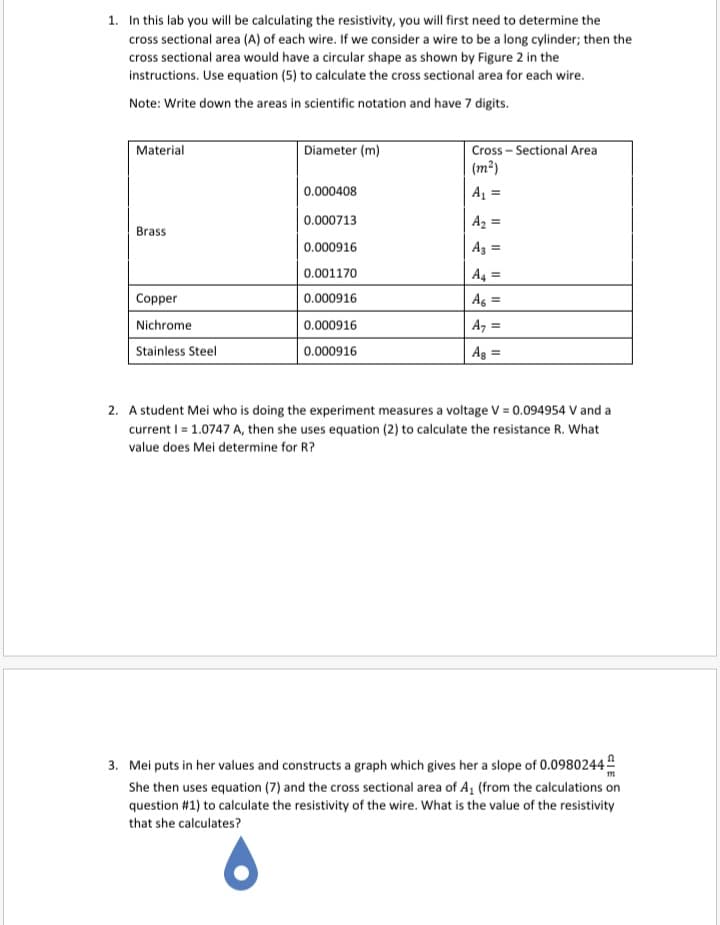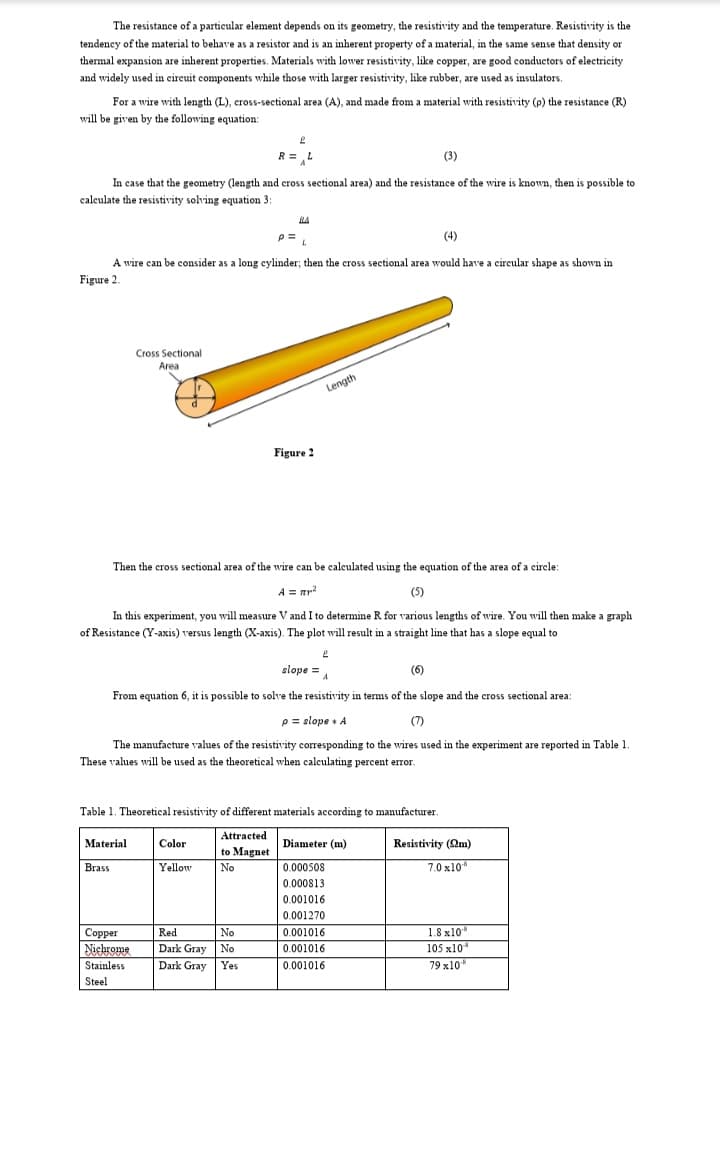1. In this lab you will be calculating the resistivity, you will first need to determine the cross sectional area (A) of each wire. If we consider a wire to be a long cylinder; then the cross sectional area would have a circular shape as shown by Figure 2 in the instructions. Use equation (5) to calculate the cross sectional area for each wire. Note: Write down the areas in scientific notation and have 7 digits. Diameter (m) Cross – Sectional Area (m2) Material 0.000408 A = 0.000713 Az = Brass 0.000916 Az = 0.001170 Copper 0.000916 Ag = Nichrome 0.000916 A, = Stainless Steel 0.000916 Ag = 2. A student Mei who is doing the experiment measures a voltage V = 0.094954 V and a current I = 1.0747 A, then she uses equation (2) to calculate the resistance R. What value does Mei determine for R? 3. Mei puts in her values and constructs a graph which gives her a slope of 0.0980244 She then uses equation (7) and the cross sectional area of A (from the calculations on question #1) to calculate the resistivity of the wire. What is the value of the resistivity that she calculates?
1. In this lab you will be calculating the resistivity, you will first need to determine the cross sectional area (A) of each wire. If we consider a wire to be a long cylinder; then the cross sectional area would have a circular shape as shown by Figure 2 in the instructions. Use equation (5) to calculate the cross sectional area for each wire. Note: Write down the areas in scientific notation and have 7 digits. Diameter (m) Cross – Sectional Area (m2) Material 0.000408 A = 0.000713 Az = Brass 0.000916 Az = 0.001170 Copper 0.000916 Ag = Nichrome 0.000916 A, = Stainless Steel 0.000916 Ag = 2. A student Mei who is doing the experiment measures a voltage V = 0.094954 V and a current I = 1.0747 A, then she uses equation (2) to calculate the resistance R. What value does Mei determine for R? 3. Mei puts in her values and constructs a graph which gives her a slope of 0.0980244 She then uses equation (7) and the cross sectional area of A (from the calculations on question #1) to calculate the resistivity of the wire. What is the value of the resistivity that she calculates?
Principles of Physics: A Calculus-Based Text
5th Edition
ISBN:9781133104261
Author:Raymond A. Serway, John W. Jewett
Publisher:Raymond A. Serway, John W. Jewett
Chapter21: Current And Direct Current Circuits
Section: Chapter Questions
Problem 63P
Related questions
Concept explainers
Ohm's law
Ohm’s law is a prominent concept in physics and electronics. It gives the relation between the current and the voltage. It is used to analyze and construct electrical circuits. Ohm's law states that the voltage across a conductor is directly proportional to the current flowing through it.
Path of Least Resistance
In a series of alternate pathways, the direction of least resistance is the actual or metaphorical route that offers the least resistance to forwarding motion by a given individual or body.
Question
Answer #2

Transcribed Image Text:1. In this lab you will be calculating the resistivity, you will first need to determine the
cross sectional area (A) of each wire. If we consider a wire to be a long cylinder; then the
cross sectional area would have a circular shape as shown by Figure 2 in the
instructions. Use equation (5) to calculate the cross sectional area for each wire.
Note: Write down the areas in scientific notation and have 7 digits.
Material
Diameter (m)
Cross – Sectional Area
(m²)
0.000408
A =
0.000713
A2 =
Brass
0.000916
Az =
0.001170
A4 =
Copper
0.000916
Ag =
%3D
Nichrome
0.000916
A, =
Stainless Steel
0.000916
Ag =
2. A student Mei who is doing the experiment measures a voltage V = 0.094954 V and a
current I = 1.0747 A, then she uses equation (2) to calculate the resistance R. What
value does Mei determine for R?
3. Mei puts in her values and constructs a graph which gives her a slope of 0.0980244
She then uses equation (7) and the cross sectional area of A, (from the calculations on
question #1) to calculate the resistivity of the wire. What is the value of the resistivity
that she calculates?

Transcribed Image Text:The resistance of a particular element depends on its geometry, the resistivity and the temperature. Resistivity is the
tendeney of the material to behave as a resistor and is an inherent property of a material, in the same sense that density or
thermal expansion are inherent properties. Materials with lower resistivity, like copper, are good conductors of electricity
and widely used in eireuit components while those with larger resistivity, like rubber, are used as insulators.
For a wire with length (L), cross-sectional area (A), and made from a material with resistivity (p) the resistance (R)
will be given by the following equation:
R = L
(3)
In case that the geometry (length and cross sectional area) and the resistance of the wire is known, then is possible to
calculate the resistivity solving equation 3:
RA
(4)
A wire can be consider as a long eylinder; then the cross sectional area would have a circeular shape as shown in
Figure 2.
Cross Sectional
Area
Length
Figure 2
Then the cross sectional area of the wire can be caleulated using the equation of the area of a circle:
A = mr?
(5)
In this experiment, you will measure V and I to determine R for various lengths of wire. You will then make a graph
of Resistance (Y-axis) versus length (X-axis). The plot will result in a straight line that has a slope equal to
slope = A
(6)
From equation 6, it is possible to solve the resistivity in terms of the slope and the cross sectional area:
p= slope + A
(7)
The manufacture values of the resistivity corresponding to the wires used in the experiment are reported in Table 1.
These values will be used as the theoretical when caleulating percent error.
Table 1. Theoretical resistivity of different materials according to manufacturer.
Attracted
Material
Brass
Color
Diameter (m)
Resistivity (Qm)
to Magnet
Yellow
No
0.000508
7.0 x10
0.000813
0.001016
0.001270
Coppen
Red
No
0.001016
1.8 x10*
105 x10
Dark Gray No
Dark Gray
Nichrome
0.001016
Stainless
Yes
0.001016
79 x10*
Steel
Expert Solution
This question has been solved!
Explore an expertly crafted, step-by-step solution for a thorough understanding of key concepts.
This is a popular solution!
Trending now
This is a popular solution!
Step by step
Solved in 3 steps with 3 images

Knowledge Booster
Learn more about
Need a deep-dive on the concept behind this application? Look no further. Learn more about this topic, physics and related others by exploring similar questions and additional content below.Recommended textbooks for you

Principles of Physics: A Calculus-Based Text
Physics
ISBN:
9781133104261
Author:
Raymond A. Serway, John W. Jewett
Publisher:
Cengage Learning

Physics for Scientists and Engineers: Foundations…
Physics
ISBN:
9781133939146
Author:
Katz, Debora M.
Publisher:
Cengage Learning


Principles of Physics: A Calculus-Based Text
Physics
ISBN:
9781133104261
Author:
Raymond A. Serway, John W. Jewett
Publisher:
Cengage Learning

Physics for Scientists and Engineers: Foundations…
Physics
ISBN:
9781133939146
Author:
Katz, Debora M.
Publisher:
Cengage Learning
